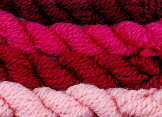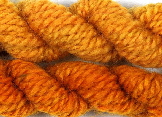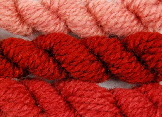|
1) Why use natural dye extracts?
2) How to use natural dye extracts
3) Proportions of natural dye extracts to use
4) Storage of natural dye extracts
5) Cost of natural dye extracts
6) Gallery of natural dye colours on wool (opens a new page)
Why use natural dye extracts?
Although it is rewarding and exciting to dye fibres directly from plants that you have grown yourself, dye extracts have several advantages. They are;
- Economical – a small amount of plant extract dyes a large amount of fibre
- Very concentrated, using up little storage space
- Easy to repeat a colour if you keep careful records
- Easy and cheap to transport
- They save time as they do not require lengthy pre-soaking and simmering
- Dye plant extracts have no waste in the form of wet leaves or roots to dispose of at the end, &
- Two or more dye extracts can be mixed to obtain different dye colours.
- Many of our dye extracts are approved dyestuffs for the Global Organic Textile Standard (GOTS 4.0)
How to use natural dye extracts
Before you start, please read our safety guidelines.
Make a paste with 1 teaspoon (5 grams) extract and a small amount of warm water. Fill a saucepan with water and add the dissolved extract. Alternatively, you can sprinkle the extract on the water in the saucepan. Some extracts need more stirring than others to dissolve properly.
Add pre-wetted mordanted fibre. Bring the dye bath to simmering point slowly (do not go over 60°C for madder) and then simmer gently for 45 to 60 minutes. Stir gently from time to time. Leave overnight to cool and dry your dyed fibre in the shade and away from intense heat.
Proportions of dye extracts to use
The amount you use will depend on the particular dye extract and on the natural dye colour you want to achieve. On average, 1 teaspoon (5 grams) of extract will dye 50 grams of fibre a good colour, or 100 grams of fibre a lighter colour. Some extracts will dye less than that and cochineal will dye more. We advise you to experiment, as dye colours will vary with the type of fibre, the mordant and the quality of water, and always dye a small sample first before dyeing a large quantity of fibre.
For strong extracts (for example chlorophyllin, cochineal, brazilwood and logwood), it is best to use only 2 grams of extract per 100g of mordanted wool. If you want a darker shade, then you need to mordant the wool again and make a second dye bath with another 2 grams of extract. Dyeing twice is recommended instead of using a more concentrated bath.
I usually add 25 grams of fibre to a dye bath made with 5 grams of extract to a get a dark colour and then I add another 25 grams of fibre. Depending on the colours I obtain, I may add another one or two 25 grams batches of fibre.
Storage of natural dye extracts
Dye extracts are very sensitive to moisture and some types will go hard with time (e.g. dyers greenweed, sorghum, goldenrod), especially if left in the open.
Avoid measuring the dye or storing it in a steamy kitchen. Some extracts can change colour as well as going hard, coreopsis for example, goes very hard and black when left in an open bag. This does not seem to affect the results, however, and the extracts will still produce good colours. Hardened powder is, however, more difficult to measure. Therefore, expel as much air as possible from the plastic bag when re-sealing it. Seal it well and put the closed bag inside another grip seal bag. If well looked after, the extracts can last for quite a while.
If your extract has become hard you can still use it. Put the extract in a heat-proof container and add a bit of hot water. Leave it for 5 minutes stirring from time to time. If necessary, pour the dissolved dye into the saucepan you are going to use for dyeing and add more hot water to the extract.
Cost of natural dye extracts
Dye extracts may look a little pricey at first but they are very economical when you take into account their concentration. If you compare the price of 20 grams of weld extract, for example, with 100 grams of weld dye plant, you will see that they are good value.
See also:
1) variation in dye extracts strength or
2) Gallery of natural dye colours on wool
with Chlorophyllin, Cochineal, Coreopsis, Cutch, Dyers Greenweed, Logwood, Madder, Old Fustic, Sorghum and Weld natural dye extracts!
Top of page
|







